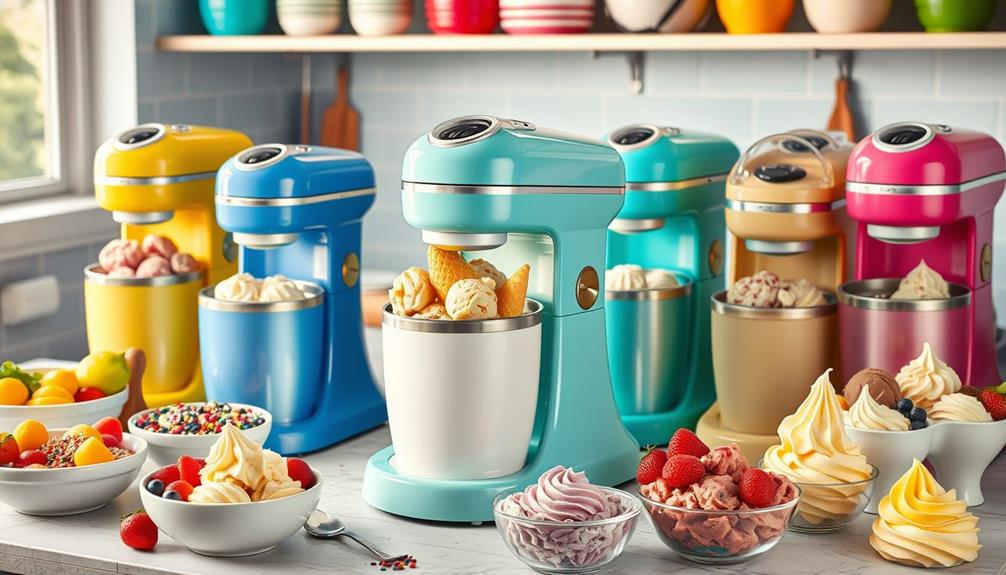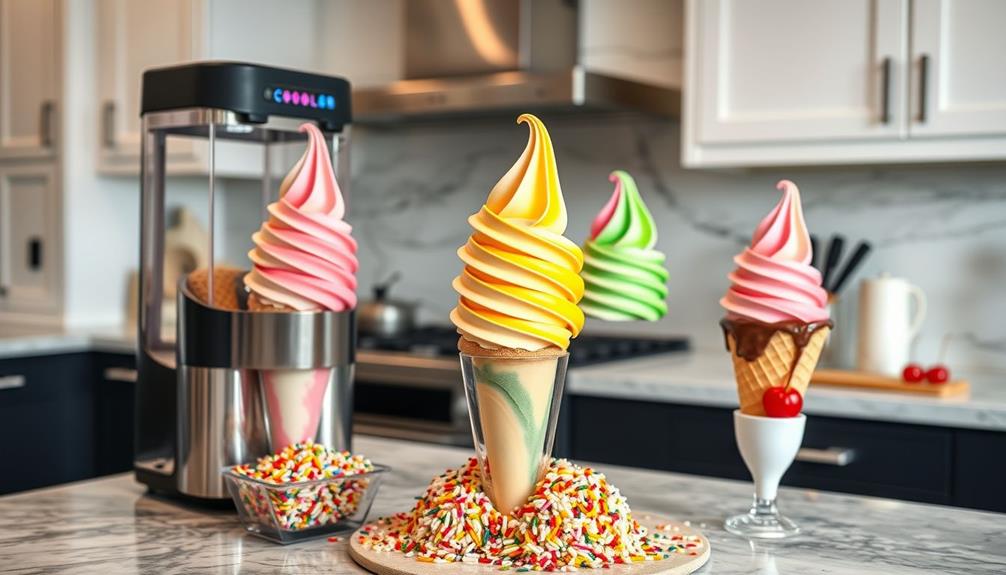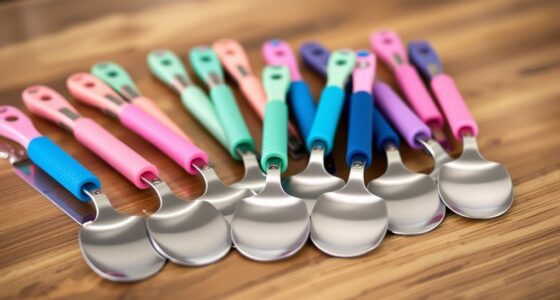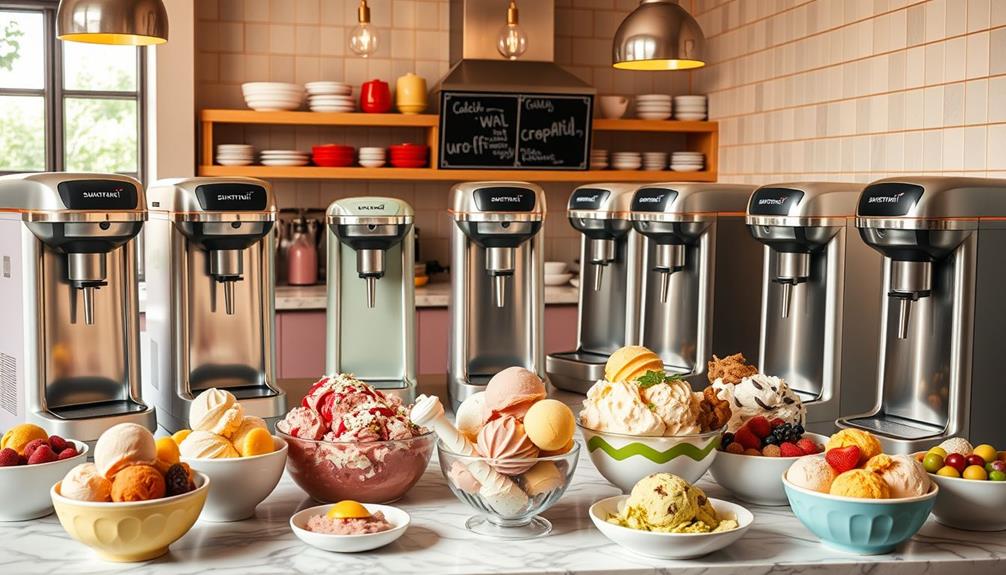If you're looking to make your own ice cream at home, I've found 15 fantastic at-home ice cream makers that suit various needs. For small batches, the Cuisinart ICE30BCP1 offers a 2-quart capacity and makes ice cream in about 25 minutes, while the Ninja CREAMi provides customizable flavors with its three-step process. Larger gatherings can benefit from the Elite Gourmet's 6-quart model, which churns out plenty for everyone. With features like built-in compressors and easy-to-clean designs, these machines simplify the ice cream-making process. Stick around, and you'll find more detailed insights on each model to help you choose the best one.
Key Takeaways
- Consider the ice cream maker's capacity, ranging from 0.5 pints to 6 quarts, to suit your serving needs and family size.
- Choose between models with built-in compressors for instant use or traditional types that require pre-freezing bowls for optimal results.
- Look for versatile machines that can create various frozen treats like gelato, sorbet, and frozen yogurt, enhancing your dessert options.
- Evaluate production speed, as some machines can make ice cream in as little as 20 minutes, perfect for spontaneous cravings.
- Check for user-friendly features, such as LCD control panels and easy-to-clean removable parts, to simplify the ice cream-making process.
Cuisinart Ice Cream Maker (ICE30BCP1)

If you're someone who loves homemade ice cream but doesn't want to deal with complicated machinery, the Cuisinart Ice Cream Maker (ICE30BCP1) is a fantastic choice. This fully automatic machine can make delicious frozen desserts in just 20 to 25 minutes. It has a 2-quart capacity, perfect for sharing with family or friends. The sleek silver design with brushed stainless steel adds a modern touch to your kitchen. You'll find it easy to use, thanks to the large ingredient spout for mix-ins. Just remember to freeze the bowl overnight for best results. Plus, it comes with a three-year warranty, giving you peace of mind as you whip up your favorite flavors!
Best For: Home cooks who enjoy making homemade ice cream quickly and easily.
Pros:
- Easy to use with fully automatic operation and a large ingredient spout for mix-ins.
- Quick freezing time, producing delicious ice cream in approximately 20-25 minutes.
- Stylish design with brushed stainless steel that complements modern kitchens.
Cons:
- Requires overnight freezing of the bowl before use.
- Produces soft serve consistency, which may not suit all preferences.
- Potential for overflow if the bowl is overfilled during operation.
Cuisinart Ice Cream Maker Machine (1.5 Quart)

The Cuisinart Ice Cream Maker Machine (1.5 Quart) is an ideal choice for anyone who craves homemade frozen desserts without the hassle. This automatic machine makes it super easy to whip up delicious ice cream, sorbet, and frozen yogurt in just 20 minutes. With a 1.5-quart capacity, it's perfect for small batches. The double-insulated freezer bowl means you won't need ice, and the easy-lock lid allows for mess-free ingredient additions. Plus, its heavy-duty motor handles all kinds of treats effortlessly. Users love its ease of use and cleanup, with a solid rating of 4.6 stars from over 15,000 reviews. Just remember to freeze the bowl for 16-24 hours before use for the best results!
Best For: Those who enjoy making homemade frozen desserts quickly and easily, without the need for ice.
Pros:
- Easy to use with simple operation and quick cleanup.
- Versatile machine capable of making ice cream, sorbet, and frozen yogurt.
- Compact size and lightweight design make it convenient for storage and countertop use.
Cons:
- Freezer bowl requires significant pre-freezing time (16-24 hours) before use.
- Limited capacity of 1.5 quarts may not be enough for larger gatherings.
- Plastic construction may not appeal to those preferring more durable materials.
Cuisinart Soft Serve Ice Cream Machine (ICE-48)

Looking to whip up delicious soft serve at home? The Cuisinart Soft Serve Ice Cream Machine (ICE-48) might just be what you need. It can hold up to 1.5 quarts of your favorite treats and makes ice cream in just 20 minutes, without any chemicals, salt, or ice. This fully automatic machine features a double-insulated freezer bowl for quick results. You can create soft serve, yogurt, or even sorbet! Plus, it has three condiment containers and a holder for extra cones, making customization easy. Although some users mention it can be tricky to clean and achieve the perfect consistency, many love the quick production and flavor options. With a limited three-year warranty, you'll have peace of mind while experimenting with your creations.
Best For: Those who enjoy making customizable frozen treats at home, including soft serve ice cream, yogurt, and sorbet.
Pros:
- Fully automatic operation with quick 20-minute production time.
- Includes three condiment containers for easy customization of flavors and toppings.
- Dishwasher-safe components make cleaning up after use convenient.
Cons:
- Some users report difficulty achieving the desired consistency of ice cream.
- Cleaning the machine can be cumbersome and time-consuming.
- Mixed reviews on usability and overall effectiveness from some customers.
Ninja CREAMi Ice Cream Maker

Designed for ice cream enthusiasts and health-conscious individuals alike, the Ninja NC301 CREAMi Ice Cream Maker lets you craft a variety of frozen treats right at home. With its 800 watts of power, this machine can whip up ice cream, sorbet, milkshakes, and more in just three simple steps. The two-pint containers are perfect for making enough for everyone, and I love that I can customize ingredients to suit my dietary needs, whether it's keto or dairy-free.
You'll find seven one-touch programs to make your favorite treats, plus a re-spin function to achieve that creamy texture. While it can be a bit loud, the results are worth it. Overall, it's a fantastic addition to any kitchen!
Best For: The Ninja NC301 CREAMi Ice Cream Maker is best for ice cream enthusiasts and health-conscious individuals who want to create customizable frozen treats at home.
Pros:
- Versatile functionality allows for making ice cream, sorbet, milkshakes, and more.
- Customization options cater to various dietary needs, including keto and dairy-free.
- User-friendly with seven one-touch programs and a re-spin function for creamy textures.
Cons:
- Loud operation may be alarming during use.
- Requires overnight freezing of bases before processing, which can be inconvenient.
- Low-fat creations may result in dry flakes, needing additional attention during processing.
Elite Gourmet 6 Quart Electric Ice Cream Maker Machine

For families who love creating their own frozen treats, the Elite Gourmet Old Fashioned 6 Quart Electric Ice Cream Maker is a fantastic choice. It has a generous capacity, allowing you to whip up ice cream, gelato, or sorbet for everyone. The setup is simple: just mix your ingredients, assemble the unit, add ice and rock salt, plug it in, and let it churn away. With a powerful, whisper-quiet motor and a manual hand crank option, it's user-friendly for all ages. Plus, the aluminum canister is dishwasher safe, making cleanup a breeze. I appreciate the included recipe book, helping you craft custom flavors without preservatives. Overall, it's a great addition for family gatherings and delicious homemade treats.
Best For: Families looking to create their own delicious frozen treats in a fun and easy way.
Pros:
- Easy to use with a simple 3-step process that anyone can follow.
- Generous 6-quart capacity allows for making large batches of ice cream, gelato, or sorbet.
- Dishwasher-safe aluminum canister makes cleaning up quick and convenient.
Cons:
- Some users report issues with leaking buckets, which can create a mess during operation.
- There are occasional complaints about customer service challenges when seeking assistance.
- Requires outdoor use or placement in a sink due to condensation buildup during operation.
Whynter Automatic Ice Cream Maker Machine (ICM-200LS)

The Whynter Automatic Ice Cream Maker Machine (ICM-200LS) stands out with its self-cooling technology, making it an excellent choice for anyone who craves homemade frozen treats without the hassle of pre-freezing bowls. This machine has a 2.1-quart capacity, perfect for whipping up ice cream, gelato, or sorbet in about 27 minutes. I love that it features a user-friendly LCD control panel and includes an ice cream scoop.
It's easy to clean, with a removable mixing bowl and churn blade, and it operates quietly. Plus, the built-in compressor means you can make batch after batch without waiting. Users rave about its durability and the ability to create customized flavors, making it a fantastic addition to any kitchen.
Best For: Those who enjoy making homemade ice cream and frozen desserts quickly and easily without the need for pre-freezing bowls.
Pros:
- Self-cooling technology allows for continuous use, eliminating the need for pre-freezing.
- User-friendly LCD control panel simplifies the operating process, making it accessible for everyone.
- Versatile recipes can be created, accommodating a range of frozen desserts from ice cream to sorbet.
Cons:
- Limited to two batches in a row to prevent ice buildup, which may be restrictive for larger gatherings.
- The 2.1-quart capacity may not be sufficient for larger families or parties.
- Some users may find the initial investment price higher compared to simpler ice cream makers.
Whynter Automatic Ice Cream Maker Machine (ICM-201SB)

If you're looking for an ice cream maker that combines convenience and quality, the Whynter Automatic Ice Cream Maker Machine (ICM-201SB) stands out with its self-cooling technology. This impressive machine has a 2.1-quart capacity, allowing you to whip up plenty of ice cream, gelato, or sorbet in one go. What I love most is that it eliminates the need for pre-freezing, thanks to its built-in compressor. Plus, it keeps your creations from melting with an extended cooling function. The soft-touch LCD control panel makes it user-friendly, and the sleek stainless steel design looks great on any countertop. With a customer rating of 4.5 stars, it's clear this model delivers excellent quality and performance.
Best For: Those who want a high-quality, user-friendly ice cream maker for creating a variety of frozen desserts at home. There are plenty of affordable ice cream makers on the market, but this one stands out for its durability and ease of use. Its large capacity allows for making enough ice cream to serve a crowd, and its sturdy construction ensures it will last for many years of use. Overall, this ice cream maker is a great investment for anyone who loves to indulge in homemade frozen treats without breaking the bank.
Pros:
- Easy to use with a simple control panel.
- Produces a generous 2.1-quart batch size.
- Quiet operation and excellent quality results.
Cons:
- Takes up counter space.
- Concerns about the durability of the plastic paddle.
- Higher price point compared to some alternatives.
Elite Gourmet Automatic Electric Ice Cream Maker

Looking to whip up delicious homemade treats without the hassle? The Elite Gourmet Automatic Electric Ice Cream Maker could be your new best friend. This compact machine has a 1-quart capacity and operates automatically, so you don't need to worry about complicated processes. It makes ice cream in less than 40 minutes, and you can customize flavors by adding your favorite mix-ins like fruit or chocolate chips. The user-friendly control panel and easy-to-clean removable parts make it even more appealing. Plus, it comes with a variety of recipes to inspire your culinary creativity. Just remember to freeze the bowl overnight for the best results. With this maker, creating delightful desserts at home is a breeze!
Best For: Individuals, couples, or small families looking to easily make delicious homemade ice cream and frozen treats.
Pros:
- User-friendly control panel and automatic operation make it easy to use.
- Compact design is perfect for small kitchens and easy storage.
- Includes a variety of recipes for different frozen desserts.
Cons:
- Mixed reviews on durability and construction quality.
- Requires the bowl to be frozen overnight for optimal results.
- Some users report issues with noise level during operation.
DASH My Mug Ice Cream Maker Machine (Aqua)

For anyone craving a quick and personalized frozen treat, the DASH My Mug Ice Cream Maker (Aqua) is an excellent choice. This compact machine makes up to 0.5 pints of ice cream, gelato, sorbet, or frozen yogurt in just 20 minutes. I love that it comes with a built-in ingredient chute, making it easy to customize my creations with nuts, fruits, or chocolate chips. Plus, the innovative design allows me to use it as a freezable mug for direct consumption, which simplifies cleanup. Weighing only 4.81 pounds, it's easy to store in my kitchen. However, I've noticed that sometimes the texture can be inconsistent, so I recommend pre-freezing the mug for better results. Overall, it's a fun and convenient tool for ice cream lovers!
Best For: Individuals who enjoy creating personalized frozen treats quickly and conveniently in a compact design.
Pros:
- Versatile use for making ice cream, gelato, sorbet, and frozen yogurt in just 20 minutes.
- Built-in ingredient chute allows for easy customization with various add-ins.
- Compact and lightweight, making it easy to store and handle.
Cons:
- Some users report inconsistent freezing results, leading to a slushy texture at times.
- Requires pre-freezing the mug for optimal performance, which adds an extra step.
- Limited capacity of 0.5 pints may not satisfy larger cravings or serve multiple people.
DASH My Pint Ice Cream Maker Machine (Aqua)

The DASH My Pint Ice Cream Maker (Aqua) is perfect for anyone who craves personalized frozen treats without the hassle of larger machines. This compact device can whip up ice cream, gelato, sorbet, or frozen yogurt in just under 30 minutes, making it ideal for quick, single servings. With a capacity of 1.6 cups, it fits neatly into smaller kitchen spaces. I love how the cooling bowl keeps the temperature low, but remember to pre-freeze it for 24 hours for the best results. Although it may not perform as powerfully as larger machines, it allows for customization with your favorite add-ins like nuts and fruits. Just keep an eye on the consistency to avoid over-freezing.
Best For: Those seeking a compact and easy-to-use ice cream maker for quick, personalized frozen treats in smaller portions.
Pros:
- Compact design makes it suitable for limited kitchen space.
- Quick preparation time allows for single servings in under 30 minutes.
- Customizable recipes enable users to add their favorite mix-ins like nuts and fruits.
Cons:
- Limited capacity of 1.6 cups may not be sufficient for larger batches.
- Motor power may not mix thoroughly, leading to inconsistent results.
- Performance can vary based on room temperature and freezer conditions.
COWSAR Ice Cream Maker Machine with Built-in Compressor

With its built-in compressor, the COWSAR Ice Cream Maker Machine is perfect for those who want the convenience of making ice cream at home without the hassle of pre-freezing bowls. This fully automatic machine can create delicious ice cream, yogurt, and sorbets in just 20 to 45 minutes, depending on your recipe. It has a 1.1-quart capacity, which is great for small batches. I love that it features an easy-to-clean removable bowl and a sleek stainless steel design, complete with a soft-touch LCD control panel. Plus, the one-hour keep-cooling function guarantees my treats stay frozen longer. While it's generally quiet, I've noticed the paddle occasionally stops if the sides freeze too much, but it's easy to fix.
Best For: Those who enjoy making homemade frozen desserts without the need for pre-freezing bowls and prefer a compact, easy-to-use machine.
Pros:
- Fully automatic operation eliminates the need for pre-freezing bowls, allowing for immediate ice cream preparation.
- 1-hour keep-cooling function ensures that desserts stay frozen longer after production.
- Easy to clean with a removable bowl, making maintenance hassle-free.
Cons:
- The paddle may stop if the sides freeze too much, requiring manual intervention.
- Limited capacity of 1.1 quarts may not be sufficient for larger gatherings or families.
- Higher price point compared to non-compressor models may be a consideration for budget-conscious buyers.
Nostalgia Electric Ice Cream Maker – Vintage Wooden Style (4 Quart)

Imagine whipping up delicious homemade ice cream in just 20-30 minutes—if you love creating tasty treats for family gatherings or parties, the Nostalgia Electric Ice Cream Maker in its charming vintage wooden style is perfect for you. With a generous 4-quart capacity, this machine makes ice cream, frozen yogurt, or gelato effortlessly, thanks to its electric motor that handles all the churning. I love how easy it is to customize recipes with fun extras like strawberry preserves or cookie dough! Plus, it includes a lid and cap for storing any leftovers. Weighing just 7.48 pounds, it features a convenient carrying handle, making it portable for any occasion. Overall, it's a delightful addition to my kitchen!
Best For: Families and ice cream enthusiasts looking to create delicious homemade treats for gatherings and parties.
Pros:
- Easy to use with an electric motor that eliminates manual churning effort.
- Generous 4-quart capacity allows for making large batches of ice cream or frozen desserts.
- Nostalgic design adds charm to any kitchen and enhances the ice cream-making experience.
Cons:
- Requires ice and salt layering for operation, which can be a bit messy.
- Some users express concerns about the durability of plastic components.
- Lacks an on/off switch, which may be inconvenient for some users.
KUMIO 1.2-Quart Automatic Ice Cream Maker with Compressor

If you're someone who loves the idea of whipping up creamy homemade ice cream without the hassle of pre-freezing bowls, the KUMIO 1.2-Quart Automatic Ice Cream Maker could be just what you need. This machine features a built-in self-cooling compressor, so you can start your ice cream adventure right away. With four modes—ice cream, yogurt, single mix, and refrigeration—you have plenty of options. It holds 1.2 quarts, which is enough for about 5-6 cups of deliciousness. I appreciate the user-friendly LCD display that makes operation a breeze. Plus, the detachable parts simplify cleaning. In about 35-60 minutes, you'll enjoy creamy ice cream that rivals store-bought varieties. It's a fantastic addition for small families or anyone who loves experimenting with flavors!
Best For: Individuals or small families who enjoy making creamy homemade ice cream without the hassle of pre-freezing bowls.
Pros:
- User-friendly LCD display makes operation simple and intuitive.
- Built-in compressor allows for immediate use without pre-freezing, saving time.
- Detachable parts ensure easy cleaning and maintenance.
Cons:
- Limited capacity of 1.2 quarts may not be sufficient for larger families or gatherings.
- Durability is still to be determined as long-term performance hasn't been established.
- Hand wash recommended for components, which may be inconvenient for some users.
Americana Collection Elite Automatic Easy Homemade Electric Ice Cream Maker

The Americana Collection Elite Automatic Easy Homemade Electric Ice Cream Maker is perfect for families who want to create delicious frozen treats at home without the hassle. This 1.5-quart ice cream maker is easy to use; just freeze the bowl overnight, add your ingredients, and press a button. In under 40 minutes, you'll be enjoying soft-serve quality ice cream. I love that it includes a motorized paddle, which mixes in air for a smooth texture and lets you add toppings like cookies or fruit. Cleanup is simple since all parts are removable. While some users suggest cutting fruit into smaller pieces for best results, I appreciate the variety of recipes included. It's a great choice for family gatherings and summer fun!
Best For: Families looking to create delicious homemade ice cream and frozen treats with minimal effort.
Pros:
- Easy to use: Simply freeze the bowl, add ingredients, and press a button for quick preparation.
- Smooth texture: The motorized paddle incorporates air for a creamy consistency and allows for mix-ins.
- Convenient cleanup: All removable parts make cleaning a breeze after use.
Cons:
- Durability concerns: Some users reported issues with the dasher and motor after extended use.
- Fruit preparation needed: Larger fruit pieces may cause the paddle to struggle, requiring cutting into smaller sizes.
- Customer service mixed feedback: Reports of inadequate customer service and manual availability have been noted.
AAOBOSI 1.6 Quart Ice Cream Maker Machine

For anyone who loves making ice cream at home without the hassle of pre-freezing bowls, the AAOBOSI 1.6 Quart Ice Cream Maker Machine is an excellent choice. This machine features a powerful 150W refrigeration compressor, allowing you to whip up ice cream in less than 60 minutes. With four modes, you can create not just ice cream but also yogurt and frozen treats. The user-friendly push-button control panel, complete with an LCD display and timer, makes operation a breeze. Plus, the keep cool function helps maintain freshness. It has a large capacity, making 6-7 cups of yogurt or 10-11 ice cream balls. Cleanup is easy too, thanks to its detachable components. It's the perfect addition to your kitchen!
Best For: Families and ice cream enthusiasts looking for a convenient, quick, and versatile way to make homemade frozen treats.
Pros:
- Built-in compressor allows for spontaneous ice cream making without pre-freezing bowls.
- User-friendly control panel with LCD display simplifies operation and timing.
- Easy to clean with detachable components and included cleaning brush.
Cons:
- Relatively heavy design at 12KG may be cumbersome to move.
- Limited capacity may not suffice for larger gatherings or parties.
- Initial investment may be higher compared to simpler ice cream makers.
Factors to Consider When Choosing At Home Ice Cream Makers

When choosing an at-home ice cream maker, I think it's important to take into account several key factors. You'll want to look at the capacity and batch size, the type of freezing mechanism, and how easy it is to use and clean. Also, the speed of production can make a big difference in how quickly you can enjoy your homemade treats.
Capacity and Batch Size
Choosing the right ice cream maker involves understanding capacity and batch size, which can greatly impact your home ice cream experience. When I first started exploring ice cream makers, I quickly realized that their capacities range from 0.5 pints to 6 quarts. If you're someone who enjoys making small batches, a 1.5-quart model is perfect. It typically produces enough ice cream for 4 to 6 servings, making it ideal for small households or gatherings.
On the other hand, if you're hosting a party or planning an event, you might want to evaluate a larger model. A 6-quart capacity can create multiple batches at once, which is a game-changer for entertaining. For those of us who like to indulge in single servings, smaller machines with 0.5 to 1-pint capacities work wonders without leaving leftovers.
It's also essential to contemplate how often you'd use the machine. If you plan on making ice cream regularly, opting for a larger capacity can save you time and effort in the long run. Ultimately, choosing the right size will enhance your ice cream-making journey and keep everyone satisfied.
Type of Freezing Mechanism
After considering capacity and batch size, the next factor that considerably influences your ice cream-making experience is the type of freezing mechanism. There are mainly two types to choose from: traditional salt-and-ice methods and modern built-in compressor systems.
Machines with built-in compressors are a game-changer. They allow for continuous use without needing to pre-freeze bowls. You can whip up ice cream in just 20 to 60 minutes, making them perfect for those spontaneous cravings. On the other hand, traditional models require the freezer bowl to be pre-frozen for 16 to 24 hours. This can limit how often you can make ice cream and can be a hassle if you want something sweet on the fly.
Additionally, some machines come with double-insulated freezer bowls that don't need ice, while others still require ice and rock salt. The efficiency of the freezing mechanism also affects the texture and creaminess of your ice cream. Generally, compressor-based machines produce superior results regarding consistency and quality. So, when choosing an ice cream maker, consider how you want to enjoy your treats and the convenience you need.
Ease of Use
Making ice cream at home should be a fun and easy experience, not a complicated chore. When choosing an ice cream maker, look for models with automatic operation modes. These machines let you simply add your ingredients and start the process with just the push of a button.
User-friendly control panels with LCD displays are also a plus. They make it easy to monitor the ice cream-making process and adjust settings as needed. Built-in compressors are another feature to take into account. These eliminate the need for pre-freezing bowls, allowing you to whip up a batch of ice cream whenever the craving hits.
Detachable components are helpful, too. They simplify cleaning and help maintain hygiene after each use. Finally, I recommend opting for machines that come with clear instructions and recipes. This can really help if you're new to making ice cream, guiding you to successful results without any confusion.
Cleaning and Maintenance
While enjoying the ease of use that comes with modern ice cream makers, I can't overlook the importance of cleaning and maintenance. Choosing an ice cream maker with removable parts, like bowls and paddles, makes cleaning a breeze. I love that I can easily hand wash them or pop them into the dishwasher if the model allows it.
Another feature I look for is a non-stick interior. This helps prevent ice cream from sticking, making serving and cleanup so much easier. After each use, I always clean my machine to avoid ice cream residue buildup, which can affect both performance and flavor in future batches.
It's also essential to follow the manufacturer's care instructions. Avoid abrasive cleaners and never submerge electrical parts in water, as this can lead to damage. For best maintenance, I stick to the recommended cleaning intervals and proper storage tips. Neglecting these steps can result in mechanical issues and reduced performance over time. By paying attention to cleaning and maintenance, I can continue enjoying delicious homemade ice cream without any hassle!
Speed of Production
Considering the speed of production is essential when choosing an at-home ice cream maker. The time it takes to churn out delicious frozen treats can vary quite a bit. Some machines whip up soft-serve in as little as 20 minutes, while others may take up to an hour for firmer textures. If you're keen to enjoy your ice cream right away, look for models with built-in compressors. These allow you to make ice cream on demand without the hassle of pre-freezing bowls overnight.
Most machines can deliver a soft-serve consistency within 20 to 30 minutes, but keep in mind that firmer ice cream will need extra freezing time after the initial churning. I've noticed that machines with automatic features can really speed things up. They often complete batches faster and require less hands-on attention, making the process more efficient.
Also, consider the capacity of the machine. Larger models might churn ice cream in a similar timeframe as smaller ones, but they yield more servings per batch, making them perfect for gatherings or family treats.
Versatility in Recipes
When selecting an at-home ice cream maker, versatility in recipes is a key factor to keep in mind. I love that some machines can whip up not just ice cream, but also gelato, sorbet, and frozen yogurt. This variety lets me experiment with different frozen treats and flavors.
I've noticed that many models offer customizable options, allowing me to add mix-ins like nuts, fruits, or chocolate chips while the ice cream is churning. This feature enhances both flavor and texture, making each batch unique.
Another great aspect is the built-in compressors found in some machines. These eliminate the need to pre-freeze bowls, meaning I can spontaneously try new recipes without waiting for hours.
Many ice cream makers also come with recipe books, guiding me through everything from classic flavors to innovative combinations. This is perfect for exploring different tastes and dietary preferences.
Noise Level During Operation
Noise levels during operation can make a significant difference in the enjoyment of using an at-home ice cream maker. Some models can be quite loud, producing churning sounds that might seem alarming at first. However, that noise is often just part of the machine's design. If you live in a shared space or plan to make ice cream late at night, you'll want to reflect on quieter options.
Many ice cream makers come with quieter motors, which makes them better suited for home use. Those with built-in compressors usually operate more quietly than those requiring pre-frozen bowls. The compressor models don't churn as vigorously, so they tend to be less noisy.
You may also want to look for machines that have rubber feet or sound-dampening materials. These features help reduce vibrations and decrease noise during operation, creating a more peaceful ice cream-making experience. Finally, if you have sensitive pets or family members who might be disturbed by the sound, take the noise level into account when choosing your ice cream maker. A little research can help you find a model that fits your needs without disrupting your household.
Price and Warranty Options
Choosing the right at-home ice cream maker often boils down to price and warranty options. Ice cream makers can range from about $30 for basic models to over $300 for high-end machines that come with built-in compressors and extra features. If you're on a budget, you might find a simple model that churns out decent ice cream, but keep in mind that these may have fewer features and slower processing times.
When it comes to warranties, most ice cream makers offer limited coverage that lasts from one to three years. This typically includes protection against defects in materials and workmanship. It's worth checking the warranty terms, as some brands offer extended warranties for a little extra cost, which could be a smart investment.
Before you buy, I recommend looking at customer reviews that discuss warranty claims and their experiences with the manufacturer. This can give you a better idea of the reliability and customer service you can expect. Balancing price with a solid warranty can help you make a choice that's right for your ice cream-making adventures!
Frequently Asked Questions
How Long Does It Typically Take to Freeze Ice Cream at Home?
When I make ice cream at home, it typically takes about 4 to 6 hours to freeze completely. I usually check on it periodically, ensuring it's creamy and not too hard. Patience is key!
Can I Use Alternative Milks in These Ice Cream Makers?
Absolutely, I've used almond and coconut milk in my ice cream maker. They create creamy textures and unique flavors. Experimenting with different alternatives gives me exciting results, so don't hesitate to try your favorites!
What Is the Difference Between Soft Serve and Hard Ice Cream?
I've always found soft serve to be creamier and airier, while hard ice cream has a denser texture due to less air. The serving temperature also plays a big role in how they feel!
Are These Machines Easy to Clean After Use?
I've found these machines are generally easy to clean after use. Most parts are removable and dishwasher-safe, making cleanup a breeze. I just rinse everything off, and I'm ready for my next ice cream adventure!
Can I Make Sorbet or Frozen Yogurt With These Makers?
Did you know that nearly 30% of Americans prefer sorbet over traditional ice cream? I've found that many at-home ice cream makers can easily whip up delicious sorbets and frozen yogurts, making them incredibly versatile.
Conclusion
To sum up, choosing the right at-home ice cream maker can seem overwhelming, but it's worth it for the joy of creating your favorite desserts. You might worry about the cost or space, but many models are affordable and compact. By considering your needs and preferences, you can find a machine that fits your lifestyle. With the right ice cream maker, you'll enjoy delicious, homemade treats any time you want, making it a fun addition to your kitchen.









